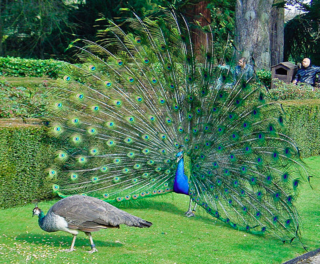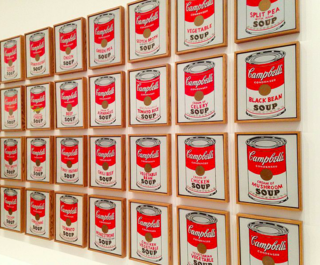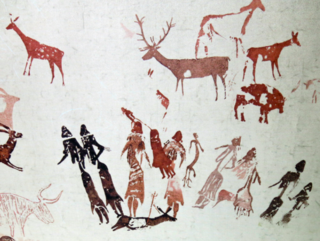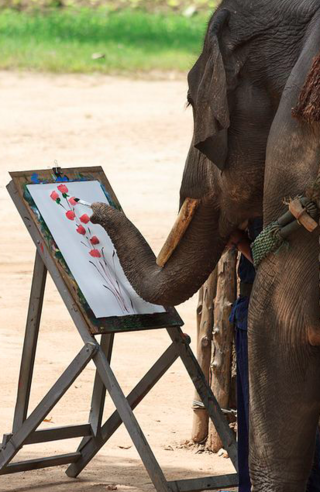Examples of Art That Create Some Form for Human Purpose

Source: noonexy/Pixabay
Ane area of the human feel that seems not to have parallels out in nature is the arts. It is difficult to conceive of a dove Picasso or a baboon Botticelli. Indeed, but a few animate being species have even the faintest hints of the showtime of culture. Without culture, there really tin't be fine art, every bit nosotros know it, because art cannot be separate from civilisation. Fine art reflects culture, transmits civilization, shapes culture, and comments on civilisation. There is but no way that animals can mayhap experience art as we practice.
And at that place is the rub. Of class, they don't experience art as we do because they don't experience annihilation as we do. And nosotros don't experience anything as some other animal does either. But if we really think near what art is and how it first began in humans, we might indeed see budding artists among our creature friends.
Art is about dazzler
If we divorce fine art from its cultural implications, we tin can agree that art is very often all to do with the expression of beauty. Throughout history, much artwork was made for no other explicit purpose than the product of beauty. Artwork is to be beheld and admired. It is breathtaking and can even make usa emotional. Information technology is this dazzler that I draw the outset connection between nature and art. Nature and art are both beautiful, no affair how you define beauty. They both can dazzle us and agree us breathless. They tin can inspire u.s. and make us experience connected to something. They both can strike an emotional nerve that leaves an impact on us that is not soon forgotten. Perhaps this connection between art and emotion reveals something well-nigh the origin of art.
Starting time, let'due south consider a specific subset of the beauty we find in the natural world: beautiful animals. From the unmatched colors of a tropical macaw to the flowing mane of an African king of beasts, to the hit features of a mandarinfish, animals are beautiful. But never was the maxim, "dazzler is in the heart of the holder" more true than in the brute world. The vivid and flashy colors that nosotros see in many animals take evolved to exist conspicuous, to assist the animal "stick out." The most spectacularly beautiful animals are so decorated in order to go the allure, respect, or fright of other animals. In all cases, the utility of the beauty is found in the reaction it gets from the observer. Can't the exact same affair be said of homo art?

Source: ToastyKen/WikiCommons
Although it'south non all about sex, much of creature beauty is indeed about impressing potential mates. To date, scientists take found no other reason that peacocks accept those cute and intricate tails except that peahens seem to dig them. These tails are not a small decorative adornment, either. The peacock tail is more than than 60% of its body length. When they try to walk, let alone fly, with those obnoxious monstrosities, it is a pitiful sight indeed.
Nevertheless, peahens are deeply attracted to this tail, and peafowl are not the but species with a strategy like this. Beginning in the simplest of invertebrates, colorful and striking ornament has been used to attract mates. I could requite a long listing of beautifully colored animals whose intricate visual patterns are designed for no other purpose than attraction of a mate, but I don't think it's necessary.
Art and beauty evoke an emotional response
This beauty-as-sexy phenomenon has a deep biological parallel with human fine art because it is the connectedness of a visual stimulus with an inner emotional country. In the case of an attractive animal, the external physical beauty is transformed into a desire, a behavioral impulse in the brain of the observer. When peahens behold a beautiful peacock, they are "moved" by it, in the sense that it affects their current mental land. We know this because it affects their behavior and nosotros assume that behaviors spring from mental states. This is exactly what the fine arts are all about in humans: they use a visual stimulus to affect the mental or emotional land of the viewers.

Source: Maurizio Pesce/WikiCommons
Art induces recollect of by events or emotions
Admittedly, art and dazzler in humans is more than just sex appeal. The effectiveness of fine art depends on some basic assumptions about the noesis and experience that is common between the creative person and the audition. Andy Warhol's Campbell'due south Soup Cans will probably take very little impact on the bushmen of eastern Africa. Art capitalizes on specific stored memories and associations in the encephalon of the observer. Hither, we have the second clue to the origin of fine art in humans: visual recollect of past events and emotions.
As human brains became more sophisticated over the last million years, nosotros became capable of storing extensive details as memories, a skill that came in handy as our behaviors became more than detailed. The hunting and gathering manner of life common to all of the various hominid species required all-encompassing visual memory. How else could they take accomplished organized group hunting, fashioning of simple tools, and the deciphering of the migratory patterns of large game on the African savannah? These complicated skills require the comparison of electric current visual cues with by experience in a computational and predictive way. Design recognition is what we are talking about hither.

Source: Enric/WikiCommons
Further all the same, the ability to brand and employ tools, a skill that began in apes and exploded in hominids, requires a keen deal of visual and tactile retention. As fully modern Man sapiens began making tools that were more and more than sophisticated, we all of a sudden constitute ourselves with the ability to describe our memories using primitive painting implements. With our newfound cognitive abilities, our impressive retention-call back, and eventually tools, it is not at all surprising that the first art produced past our ancestors depicted the very subject area that probably spawned all of our cognitive abilities in the first place: the hunt.
Cave paintings are the earliest artifacts that anthropologists and art historians agree are truly fine art, but I find it hard to believe that they didn't besides facilitate functions in the communities in which they were created. We could speculate all twenty-four hour period about what those functions could take been, but I recollect the signal is that the benefits of being able to create a visual representation was immediately recognized. I also seriously dubiety that the cave paintings were the offset such attempts at visual representations. They were merely the showtime that ended up surviving through the eons.
Fine art aids in communication and education

Source: dave parker/Flickr
As linguistic communication was developing in Homo sapiens during the great leap forrad, humans began teaching each other well-nigh the tools they'd fabricated, the food they found, and the skills they had perfected. This was the beginning of the concept of educational activity. I tin can't imagine that the instruction of the paleolothic era didn't likewise make apply of visual aids, like didactics does today. Whether they were just crude drawings fabricated by dragging sticks in the dirt, or more than elaborate representation on stone "canvases," I am sure that drawings accompanied spoken language (or gestures) right from the beginning. One time again, the key feature was the ability to use visual representations to induce memory think or visual understanding. By drawing something, an early human could make some other human remember something.
Various forms of cartoon, painting, and other visual depictions almost certainly facilitated advice and teaching among early humans. That much seems rather obvious. In addition, it seems likely that early humans as well used the new innovation of artistic depictions for diverse efforts of problem-solving and calculation. Every bit noesis connected to develop, it began to grow into consciousness and introspection as we retrieve of them today.
The visual arts were probably right there with usa along the way, helping to provide a means to express the complex thoughts that were beginning to materialize in our massive brains. Indeed, appreciation and understanding of art seem to be among the highest-order functions of the homo encephalon.
For these reasons, I tend to believe that creative expression and reactions to fine art evolved hand-in-paw with higher cerebral functions in early humans. It is natural that the new richness of our inner feel would also manifest in creative outward expression. In turn, the communication of that inner feel through art would find receptive observers and the phenomenon of art and then became ingrained culturally.
I also fully expect that artistic talent would have eventually been transferred from our culture to our genes. Afterwards all, during a million or two years of natural selection, creative ability was likely to confer some advantage on those that had it. This advantage could take come in the class of increased social standing as a leader in the hunt, a prolific teacher of skills, and so on. Any special place in the social structure means greater odds of reproductive success. In this way, I suspect, humanity evolved into a species of artists and art enthusiasts.
Practise other animals make art?
One time humanity adult a tendency to produce artistic renderings, there was plenty of biological space for information technology to flourish and reasons why it would be favored, but how might it have emerged in the first place? Surely the beliefs of art production cannot exist traced to a singular mutation. What precursors might take existed that immune art to emerge? Are in that location whatever examples of animals making something we would consider aesthetic?
There is an Indian artist named Siri, whose drawings currently get for hundreds or thousands of dollars. She has been written nearly extensively and featured in publications from Harper's Weekly to the Los Angeles Times. Her work ranges from abstruse to highly representational art including landscapes and self-portraits. Of class, she trained for many years to develop this skill, but she can at present complete a painting in mere minutes. Siri is a l year old Asian Elephant.

Source: liquidkingdom/Flickr
Siri is non solitary. Scores of elephants take been taught to pigment. The art that these elephants produce by property a brush in their trunks is truly impressive. It's certainly meliorate than anything I could produce. What these elephants are really doing, in terms of producing art or simply repeating a trained task, is the subject of heated debate. I don't intend to wade into those murky waters. Rather, I mention painting elephants here but to bespeak that the technical skill set necessary to produce art is certainly not unique to humans. These trained painting elephants tin can take a visual stimulus, even one that is new to them, and recreate it through artistic techniques that they have learned. They capeesh color, perspective, and proportion, at to the lowest degree in the basic sense. I'm not maxim that these elephants are Cézanne, but they're improve than Nathan H. Lents, that'south for sure.
In species closer to us, orangutans, chimpanzees, and gorillas have all been taught to draw and paint. Similar the elephants, some of them are quite good at it. Unlike the elephants, in that location is piffling contend that these primates seem to actually enjoy making the art and will practice information technology spontaneously, without reward, and for its own sake. They sometimes make fine art that they become quite attached to and never actively show to anyone else.
Once again, I don't desire to get into a discussion of what this fine art creation actually says almost chimpanzee consciousness, although that is interesting to me. My point here is simply that these great apes all have the physical power to create visual representations, they enjoy doing and so, and the art that they produce seems to mean something to them. All of those abilities and features were manifestly present in early humans and their ancestors as well.
And then it was not really that big of a jump when early humans looked up at the cave wall, dimly lit past a dying burn down... and saw a canvas.
richardsondustrads.blogspot.com
Source: https://www.psychologytoday.com/us/blog/beastly-behavior/201709/why-do-humans-make-art
Post a Comment for "Examples of Art That Create Some Form for Human Purpose"